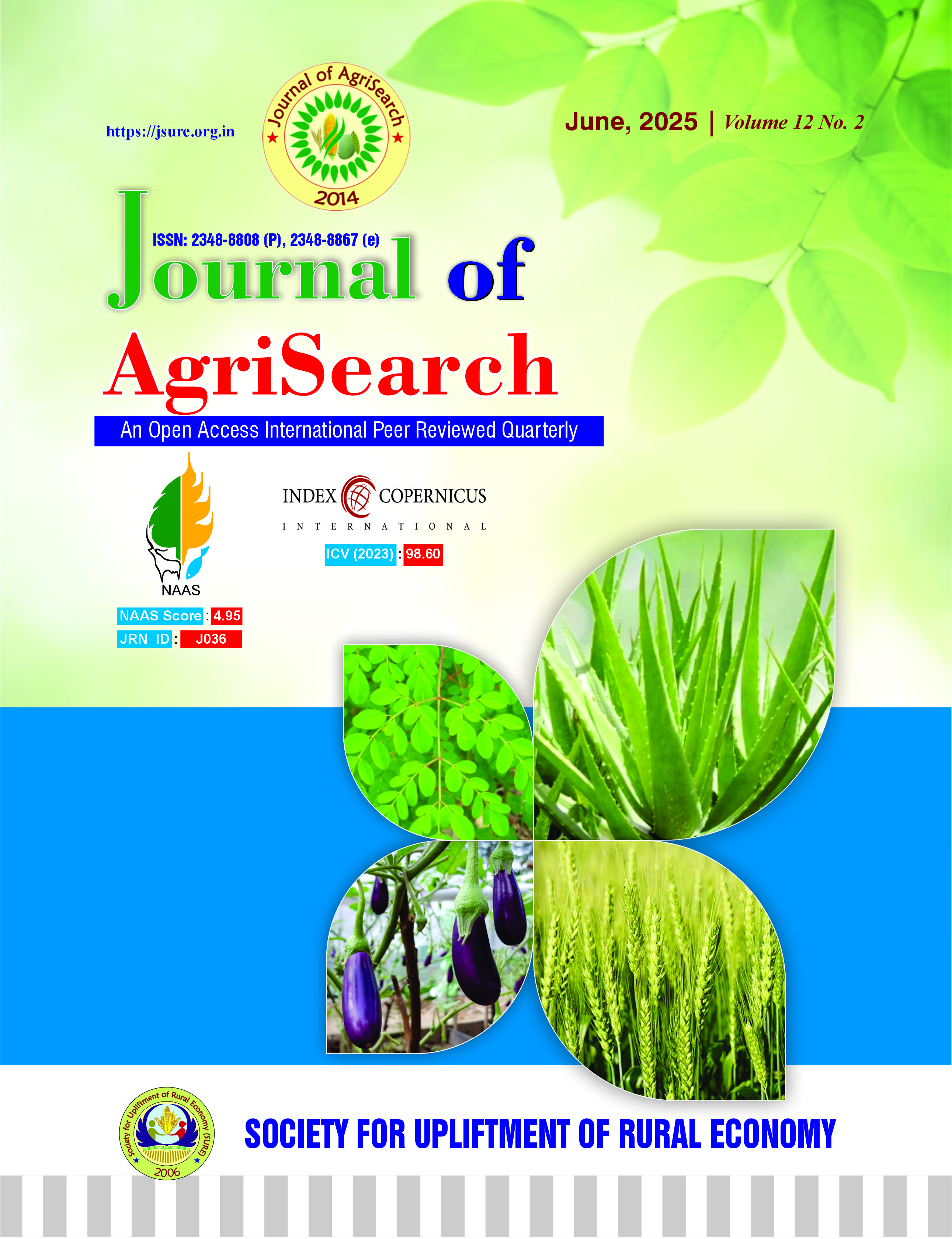Empowerment and its relationship with the socio-demographic profile of SHG women beneficiaries under NRLM in the Basti district of Uttar Pradesh
SHG women empowerment under NRLM in Basti, U.P.
DOI:
https://doi.org/10.21921/jas.v12i012.15235Keywords:
Women empowerment, Chi-square test, Education, Economic motivationAbstract
Empowerment challenges existing power dynamics and gains greater control over resources and decision-making, achieved through awareness, skill development, and active participation in developmental initiatives. The present study was conducted to examine the relationship between empowerment and the selected socio-demographic profile of the SHG women beneficiaries. A total of 120 respondents were selected through multistage cum random sampling. The collected data were analyzed using the Chi-square test to determine the association between empowerment and various selected independent variables. The results showed that the majority (69.16%) of the respondents were aged between 29 to 46 years, with a primary-level education. The majority (48.33%) of the respondents belonged to the other backwards classes (OBC), 62.50% lived in nuclear families, and 87.50% of the respondents were marginal farmers. Agriculture was identified as the main occupation by 51.66% of the respondents, with a medium level of annual family income between Rs. 100000 to 200000. Additionally, 75% of respondents had medium levels of both mass media exposure and economic motivation. The results revealed that the education (0.0027), occupation (0.00239), and family Income (0.00976) were positively associated at the 0.01 level, while age (0.0486), mass media exposure (0.02760), and economic motivation (0.02848) were significant at the 0.05 level. It means six variables significantly exert their influence on the empowerment of women.
References
Akshitha S R, Jahagirdar K A and Manjula N. 2021. Performance of Sthree Shakti Groups and socio-economic characteristics of its members of Dharwad district of North Karnataka, India. Journal of Experimental Zoology India 24(2): 1483.
Das J K, Bhattacharjee S, Datta J, Mazumder G and Laskar T. 2019. Influence of Socio-economic Factors on Empowerment of Farm Women: An In-Depth Analysis. Int. J. Curr. Microbiol. App. Sci. 8(7): 967-977.
Ghosh S. 2017. Relationship between SHG Women's Socio-Economic Factors and Empowerment in Medak District. IPE Journal of Management 7(2): 64-75.
Kabeer N. 1999. Resources, agency, achievements: Reflections on the measurement of women's empowerment. Development and Change 30(3): 435–464. https://doi.org/10.1111/1467-7660.00125
Kumar A and Sinha A. 2020. Impact of SHGs on women empowerment in India. Journal of Rural Development Studies 37(3): 45–56.
Kaushal S K and Singh Y K. 2016. Socio-economic correlates of women empowerment. Indian Research Journal of Extension Education 10(2): 81-84.
Ministry of Rural Development (MoRD). 2020. Annual Report 2019–2020. Government of India.
Ministry of Rural Development (MoRD). 2021. Annual report 2020–21. Government of
India. https://rural.nic.in
Ministry of Rural Development (MoRD). 2011. Framework for implementation: National Rural Livelihoods Mission (NRLM). Government of India. https://aajeevika.gov.in
NABARD. 2018. Status of microfinance in India 2017–18. National Bank for Agriculture and Rural Development. https://www.nabard.org
Nayak T, Singh A K, Hashim M and Singh S K. 2021. To Study the Socio-economic Profile of SHG Members in Tentulikhunti Block of Nabarangpur District (Odisha). Int. J. Curr. Microbiol. App. Sci. 10(03): 1196-1200.
Paramasivam S. 2022. Socio-economic characteristics and empowerment of women's self-help and non-self-help groups in Tamil Nadu. Indian Journal of Economics and Development 18(4): 892-899.
Singh K. 1999. Rural development: Principles, policies and management. Sage Publications.
Singh S K, Jakhar K and Singh A K. 2017. Study on Knowledge and Adoption of Black Gram Production Technology by Farmers in Mirzapur District of Uttar Pradesh. Trends in Biosciences 10(19): 3520-3523.
Singh S K and Singh A K. 2024. Study on the level of knowledge and adoption of improved urd production technology and its relationship with socio-demographic profile of the farmers: Socio-demographic impact on urd cultivation. Journal of AgriSearch 11(02): 123-127.
World Bank. 2023. Rural population (% of total population) India. https://data.worldbank.org/indicator/SP.RUR.TOTL.ZS?locations=IN
Downloads
Published
Issue
Section
License
Copyright (c) 2025 Shani Kumar Singh

This work is licensed under a Creative Commons Attribution-NonCommercial-NoDerivatives 4.0 International License.
Publisher and Authors

